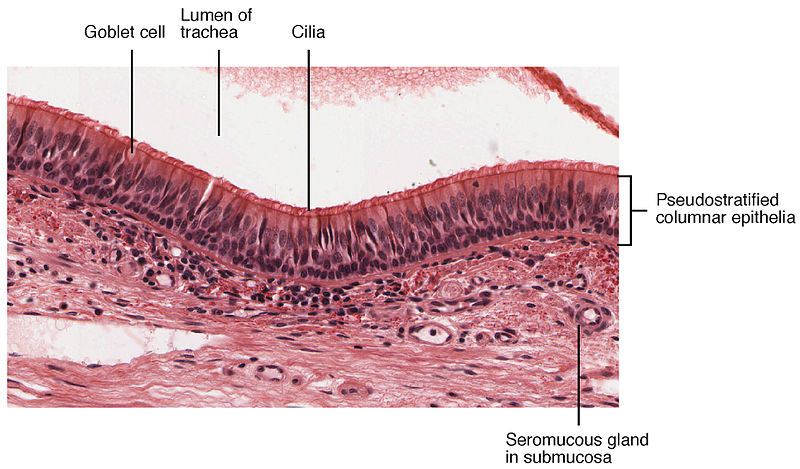A collaborative research effort identified two types of cells that the SARS-CoV-2 virus likely uses as entry points into the human body.

Image Anatomy & Physiology, Connexions website via Wikimedia.
Goblet and ciliate cells in the respiratory tract express high levels of two proteins known to facilitate the entry of the virus into human cells, reports a new study. The authors, which include members of several universities and the Human Cell Atlas Lung Biological Network say that their findings could help explain the high transmission rate observed in COVID-19.
The vulnerable link
“We found that the receptor protein — ACE2 — and the TMPRSS2 protease that can activate SARS-CoV-2 entry are expressed in cells in different organs, including the cells on the inner lining of the nose,” says Dr Waradon Sungnak, the first author on the paper from Wellcome Sanger Institute.
“We then revealed that mucus-producing goblet cells and ciliated cells in the nose had the highest levels of both these COVID-19 virus proteins, of all cells in the airways. This makes these cells the most likely initial infection route for the virus.”
The research comes as part of a wider effort that aims to use the databases of the Human Cell Atlas to understand how pathogens can infect our bodies.
The coronavirus is transmitted through respiratory aerosols generated when we cough, talk, or breathe. It’s believed that the tiny particles of liquid in these aerosols can enter our respiratory systems and, once there — like all coronaviruses — it infects our cells. But not all cells are created equal, and they need to have the right kind of transport proteins for SARS-CoV-2 to be able to penetrate their outer membranes. Exactly which cells are vulnerable to this particular virus was, until now, still unclear.
In order to find out, the team analyzed single-cell RNA sequences from multiple Human Cell Atlas (HCA) datasets. They were looking for cells which express high levels of both the proteins ACE2 and TMPRSS2, which are known to mediate infection. The team looked at cells in over 20 different tissues from the lungs, nasal cavity, eyes, gut, heart, kidneys, and liver.
Nose, eyes, guts

Image credits Scientificanimations.com via Wikimedia.
Apart from the goblet cells and ciliated cells, they report that some cells in the eye’s cornea and in the lining of our intestines also show high levels of the proteins. This would suggest that the eyes and tear ducts, alongside the gastrointestinal tract, may also represent avenues of infection.
Furthermore, the genes that encode ACE2 seem to be activated as part of the natural immune response of our organism, leading to higher levels of this protein being expressed when cells in the body are damaged or infected.
“This is the first time these particular cells in the nose have been associated with COVID-19,” explains Dr Martijn Nawijn, from the University Medical Center Groningen in the Netherlands, co-author of the study.
“While there are many factors that contribute to virus transmissibility, our findings are consistent with the rapid infection rates of the virus seen so far. The location of these cells on the surface of the inside of the nose make them highly accessible to the virus, and also may assist with transmission to other people.”
Understanding the exact avenue of infection can help guide the development of new treatments to limit its ability to spread between individuals, the team explains. It can even help us in our efforts to design a vaccine.
Because the results were obtained using different methods than those applied so far but are still consistent with previous results, they help confirm and deepen the reliability of our knowledge of the virus so far.
The paper “SARS-CoV-2 entry factors are highly expressed in nasal epithelial cells together with innate immune genes” has been published in the journal Nature Medicine.






